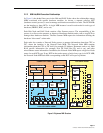
ADCP-75-192 • Issue 2 • June 2007
Page 18
© 2007, ADC Telecommunications, Inc.
2.3 Tenant Relationships
In Figure 8 on the previous page, the dotted lines among Hubmaster and Hub/RAN nodes
illustrate tenant relationships.
Once a tenant is created using the BTS Connection of the previous section, a Tenant process is
launched to manage that new tenant. This tenant process uses the Tenant OAM MIB in the
Hubmaster node to allow tenant specific objects to be configured. These objects allow the
setting of frequency, gain, and delay values as well as any other tenant specific information.
When these values are set, the Tenant process pushes this information to the Equipment MIB at
the appropriate node(s).
In addition, the Tenant process uses the Tenant OAM MIB to report any status information
about the tenant, such as hardware faults and RAN location information, which is gathered from
the Equipment MIBs at the Hub/RAN nodes.
Tenant processing determines the location of its related nodes and hardware using a process
called the Tenant Scan process that polls the Equipment MIBs located at each node in the
network. If the Equipment MIB indicates that there is hardware belonging to that tenant on that
node, the Tenant process in the Hubmaster will add that node to its “managed node” list. The
Tenant process will then use the Equipment MIBs on its managed nodes to interface to the
hardware equipment belonging to it. The Tenant Equipment process on each Hub/RAN node
will process all Equipment MIB requests and will report all tenant equipment status in the
Equipment MIB.
In the Hub/RAN nodes, the Node Paths process is responsible for detecting tenant equipment
using the results of the Pathtrace MIB and reporting this information in the Node Path MIB. In
effect, the information of the Node Path MIB is just a reorganization of the Pathtrace MIB
information to simplify the Tenant Equipment process. The Tenant Equipment process uses the
information in the Node Paths MIB to identify equipment belonging to specific tenants.
The information reported in the Pathtrace MIB is generated by the Pathtrace process on each
Hub/RAN node. The Pathtrace process examines the pathtrace fields of each HCP MIB and
reports them in a single MIB containing only information related to pathtrace, such as the HCP
type and location, as well as the pathtrace string value itself.
Tenant processes in the Hubmaster push down gain control information from the Tenant OAM
MIB to the Forward/Reverse Gain MIB’s located in the Hub/RAN nodes. Forward/Reverse
Gain processes use the values set in the Forward/Reverse Gain MIB’s as target values when
managing the gain in those nodes.
The Forward/Reverse Gain processes in the Hub/RAN nodes use the Equipment MIB to
determine the location of the hardware belonging to the tenant whose gain is being managed.
The Forward/Reverse Gain processes then access the HCP MIBs to read power values and set
attenuator values as part of gain control. The results of the gain control processes are then
reported into the Forward/Reverse Gain MIBs.


















